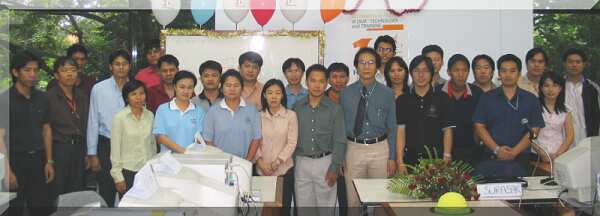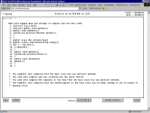ต.ย.ฝึกสอบ ที่ http://www.thaiall.com/scjp
รายชื่ออาจารย์ที่ได้รับ Java Certified Trainer รุ่นที่ 1 (22 มิถุนายน -5 กรกฎาคม 2548)
- มหาวิทยาลัยนอร์ทเชียงใหม่ อ.วิจิตร อรรถโกมล คอมพิวเตอร์ธุรกิจ
- มหาวิทยาลัยเชียงใหม่ อ.วนัสนันท์ ทองทรงกฤษณ์ วิศวกรรมคอมพิวเตอร์
- วิทยาลัยโยนก อ.บุรินทร์ รุจจนพันธุ์ วิทยาศาสตร์และเทคโนโลยี
- มหาวิทยาลัยนเรศวร พะเยา อ.พรเทพ โรจนวสุ วิทยาการคอมพิวเตอร์
- มหาวิทยาลัยเชียงใหม่ อ.โดม โพธิกานนท์ วิศวกรรมคอมพิวเตอร์
- มหาวิทยาลัยพายัพ อ.ภูมินทร์ ดวงหาคลัง วิทยาการคอมพิวเตอร์
- มหาวิทยาลัย เทคโนโลยีราชมงคลล้านนา อ.อนันต์ ทับเกิด วิศวกรรมคอมพิวเตอร์
- วิทยาลัยฟาร์อีสเทอร์น อ.เนรมิต ชุมสาย ณ อยุธยา สาขา IT คณะวิทยาศาสตร์และเทคโนโลยี
- วิทยาลัยฟาร์อีสเทอร์น อ.พิเชษฐ์ ศิริรัตนไพศาลกุล คอมพิวเตอร์ธุรกิจ
- มหาวิทยาลัยเชียงใหม่ อ.เสมอแข สมหอม ภาควิทยาการคอมพิวเตอร์ คณะวิทยาศาสตร์
จาก http://www.sipachiangmai.org/java/
 
โครงการ "จาวาภิวัฒน์" (http://www.javapiwat.org/html/java_developer.html)
เป็นความร่วมมือครั้งสำคัญระหว่างภาครัฐและภาคเอกชน อันประกอบ ด้วย สำนักงานส่งเสริมอุตสาหกรรม ซอฟต์แวร์แห่งชาติ (SIPA) ภายใต้กระทรวงเทคโนโลยีสารสนเทศและการสื่อสาร และบริษัท ซัน ไมโครซิสเต็มส์ (Sun Microsystems) ซึ่งจัดตั้งขึ้นโดยมีวัตถุประสงค์ที่จะพัฒนาประสิทธิภาพของบุคลากรด้านไอที และสนับสนุนการสร้างสรรค์นวัตกรรมเทคโนโลยีต่างๆบนพื้นฐานเทคโนโลยีจาวา อันจะนำมาซึ่งการเติบโตอย่างรวดเร็วของอุตสาหกรรมซอฟต์แวร์ในเมืองไทย และผลักดันให้ประเทศไทยก้าวสู่ความเป็นผู้ส่งออกทางเทคโนโลยีในอนาคตอันใกล้นี้
ในส่วนของแผนงาน โครงการ "จาวาภิวัฒน์" จะมุ่งเน้นไปที่การนำเทคโนโลยีมาใช้พัฒนางานใน กลุ่มหลักๆ 4 กลุ่ม ได้แก่
- กลุ่มสร้างนักพัฒนาจาวา หรือ Java Developer Cluster
- กลุ่มพัฒนาจาวาการ์ด หรือ Java Card Cluster
- กลุ่มพัฒนาเทคโนโลยีจาวาไร้สาย หรือ Java Wireless Cluster
- กลุ่มพัฒนาเครือข่ายบนระบบเปิดในประเทศไทย หรือ Thailand ONE Program
โครงการ Java Developer Cluster (JavaPiwat.Org)
เป็นโครงการที่จะสอดคล้องกับการพัฒนา นักพัฒนาซอฟต์แวร์ และผู้ประกอบการด้านซอฟต์แวร์ ให้มีความรู้ ความสามารถ ตามมาตราฐานสากล โดยทางบริษัทซันไมโครซิสเต็ม (ประเทศไทย) จำกัด จะสนับสนุนให้มีการถ่ายทอดเทคโนโลยีทางด้านจาวา และพัฒนาศักยภาพนักพัฒนาซอฟต์แวร์ไทยให้เป็น Certified Java Programmer ที่ได้รับการยอมรับตามมาตราฐานสากล ให้มีจำนวนที่เพียงพอต่อการรองรับงานซอฟต์แวร์ทางด้านจาวาที่จะนำเข้ามาสู่ประเทศต่อไปในอนาคต ซึ่งย่อมมีผลโดยตรงต่อการสร้างงาน สร้างรายได้ สร้างศักยภาพ เพิ่มมากขึ้นๆ ในอุตสาหกรรมซอฟต์แวร์ของประเทศไทยโดยรวม
วันเกิดครบ 10 ปีของ JAVA .. ตัด Cake ด้วยนะ
25-26 มิถุนายน 48 และ 2-3 กรกฎาคม 48 ทาง SIPA ให้ทุนอาจารย์ภาคเหนืออบรม JAVA หลักสูตร SL-275 และสอบ Certified Java Programmer
เรียนกันประมาณ 28 คน ต้องบอกว่าไปเรียนแต่เคล็ดวิชากันจริง ๆ เพราะเนื้อหาเยอะ และลึกมาก คนที่ไปคือคนที่มีความรู้เรื่อง Java มาก่อน ถ้าไม่มีก็ต้องบอกว่าไม่รู้เรื่องแน่ เขาไม่ได้ให้ทำ อธิบายแต่เคล็ดวิชา และทฤษฎีแต่ละเรื่องที่จะนำไปใช้ นี่ขนาดหลักสูตรเรียนเขียนโปรแกรม ยังมีแต่บรรยาย
เพราะเป็นการอธิบายเงื่อนไขของความสามารถแต่ละอย่าง กฎ และข้อยกเว้นเยอะมาก ๆ ก่อนไปผมอ่านหนังสือไปหลายเล่ม พอไปเรียนเขาให้มาอีก 2 เล่ม ถ้าไม่อ่านก็ไม่เข้าใจแน่ ส่วนเวลาเตรียมสอบ Certified Java Programmer หลังเรียนน้อยมาก ท่านวิทยากรบอกว่าเรียนเสร็จต้องกลับไปเตรียมตัวสัก 3 เดือน ก็ควรเป็นตามนั้น
แต่หลักสูตรมีข้อจำกัดเรื่องเวลาที่ต้องทราบผลการอบรมโดยเร็ว เราเรียนเสร็จก็สอบหลังจากนั้น 1 สัปดาห์ ก็ต้องลุ้นว่าจะผ่านกันกี่คน
หลักสูตรเป็นแผนการสอนของ SUN ซึ่งเป็นผู้สร้าง Compiler จึงมีความลึกในเรื่องราวต่าง ๆ มากมายเกี่ยวกับภาษานี้
ต้องขอชมคุณสุรศักดิ์ ซึ่งเป็นวิทยากรที่มีความสามารถในการอธิบายอย่างมาก พูด 2 วัน 12 ชั่วโมงเสียงไม่ตกเลย และเป็นเรื่องยาก ๆ ทั้งนั้น ทาง SUN เลือกวิทยากรได้ดีจริง ๆ ส่วนข้างล่างนี้เป็นแผนการสอน ลองอ่านดูนะครับ เพราะมีรายละเอียดหลาย ๆ อย่างหาไม่ได้จากหนังสือภาษาไทยที่มีขายในท้องตลาดแน่นอน
|
Java[tm] Programming Language
Course SL-275five daysInstructor-led or eLearning
Course Description
The Java Programming Language course provides students with information about the syntax of
the Java programming language; object-oriented programming with the Java programming
language; and creating graphical user interfaces (GUIs), exceptions, file input/output
(I/O), and threads and networking. Programmers familiar with object-oriented concepts can
learn how to develop Java technology applications. The course uses the Java 2 Software
Development Kit (Java 2 SDK).
Who Can Benefit
Students who can benefit from this course are programmers who are interested in adding the
Java programming language to their list of skills and students who are preparing for the
Sun Certified Programmer for Java examination.
Prerequisites
To succeed fully in this course, students should be able to:
Understand object-oriented principles
Create or compile simple programs in a language, such as C or C++ or have completed the
SL-110: Fundamentals of the Java Programming Language course and have created and compiled
simple Java programs
Create and edit text files using a text editor
Use an Internet browser, such as Netscape Navigator
Skills Gained
Upon completion of this course, you should be able to:
Create Java technology applications that leverage the object-oriented features of the Java
language, such as encapsulation, inheritance and polymorphism
Execute and run a Java technology application
Use Java technology data types and expressions
Use Java technology flow control constructs
Use arrays and other data collections
Implement error-handling techniques using exception handling
Create event driven GUI using Java technology GUI components: panels, buttons, labels, text
fields, and text areas
Implement I/O functionality to read from and write to data and text files
Create multithreaded programs
Create a simple Transmission Control Protocol/Internet Protocol (TCP/IP) client that
communicate through sockets
Related Courses
Before:SL-110: Fundamentals of the Java Programming Language
After:OO-226: Object-oriented Application Analysis and Design for Java Technology
After:SL-285: Java Programming Language Workshop
After:SL-301: Distributed Programming With Java Technology
After:SL-320: GUI Construction With Java Foundation Classes
Course Content
Module 1: Getting Started
--------------------------------------------------------------------------------
Describe the key features of Java technology
Write, compile, and run a simple Java technology application
Describe the Java virtual machine's (JVM machine's) function
Define garbage collection
List the three tasks performed by the Java platform that handle code security
Module 2: Object-Oriented Programming
--------------------------------------------------------------------------------
Define modeling concepts: abstraction, encapsulation, and packages
Discuss why you can reuse Java technology application code
Define class, member, attribute, method, constructor, and package
Use the access modifiers private and public as appropriate for the guidelines of encapsulation
Invoke a method on a particular object
In a Java technology program, identify the following: The package statement; The import statements; Classes, methods and attributes; and Constructors
Use the Java technology API online documentation
Module 3: Identifiers, Keywords, and Types
--------------------------------------------------------------------------------
Use comments in a source program
Distinguish between valid and invalid identifiers
Recognize Java technology keywords
List the eight primitive types
Define literal values for numeric and textual types
Define the terms primitive variable and reference variable
Declare variables of class type
Construct an object using new
Describe default initialization
Describe the significance of a reference variable
State the consequence of assigning variables of class type
Module 4: Expressions and Flow Control
--------------------------------------------------------------------------------
Distinguish between instance and local variables
Describe how to initialize instance variables
Identify and correct a Possible reference before assignment compiler error
Recognize, describe, and use Java software operators
Distinguish between legal and illegal assignments of primitive types
Identify boolean expressions and their requirements in control constructs
Recognize assignment compatibility and required casts in fundamental types
Use if, switch, for, while, and do constructions and the labeled forms of break and continue as flow control structures in a program
Module 5: Arrays
--------------------------------------------------------------------------------
Declare and create arrays of primitive, class, or array types
Explain why elements of an array are initialized
Explain how to initialize the elements of an array
Determine the number of elements in an array
Create a multidimensional array
Write code to copy array values from one array type to another
Module 6: Class Design
--------------------------------------------------------------------------------
Define inheritance, polymorphism, overloading, overriding, and virtual method invocation
Use the access modifiers protected and "package-friendly"
Describe the concepts of constructor and method overloading
Describe the complete object construction and initialization operation
In a Java program, identify the following: Overloaded methods and constructors; The use of this to call overloaded constructors; Overridden methods; Invocation of super class methods; Parent class constructors; and Invocation of parent class constructors
Module 7: Advanced Class Features
--------------------------------------------------------------------------------
Describe static variables, methods, and initializers
Describe final classes, methods, and variables
Explain how and when to use abstract classes and methods
Explain how and when to use nested classes
Distinguish between static and non-static nested classes
Explain how and when to use an interface
In a Java software program, identify: static methods and attributes; final methods and attributes; Nested classes; interface and abstract classes; and abstract methods
Module 8: Exceptions and Assertions
--------------------------------------------------------------------------------
Define exceptions
Use try, catch, and finally statements
Describe exception categories
Identify common exceptions
Develop programs to handle your own exceptions
Use assertions
Distinguish appropriate and inappropriate uses of assertions
Disable assertions at runtime
Module 9: Text-Based Applications
--------------------------------------------------------------------------------
Write a program that uses command-line arguments and system properties
Write a program that reads from standard input
Write a program that can create, read, and write files
Describe the basic hierarchy of collections in Java 2 SDK
Write a program that uses sets and lists
Write a program to iterate over a collection
Describe the collection classes that existed before Java 2 SDK
Identify deprecated classes and explain how to migrate from Java Development Kit (JDK) 1.0 to JDK 1.1 to Java 2 JDK
Module 10: Building Java GUIs
--------------------------------------------------------------------------------
Describe the Abstract Windowing Toolkit (AWT) package and its components
Define the terms containers, components and layout managers, and describe how they work together to build a GUI
Use layout managers
Use the FlowLayout, BorderLayout, and GridLayout managers to achieve a desired dynamic layout
Add components to a container
Use the Frame and Panel containers appropriately
Describe how complex layouts with nested containers work
In a Java technology program, identify the following: Containers; The associated layout managers;and the layout hierarchy of all components
Module 11: GUI Event Handling
--------------------------------------------------------------------------------
Define events and event handling
Write code to handle events that occur in a GUI
Describe the concept of adapter classes, including how and when to use them
Determine the user action that originated the event from the event object details
Identify the appropriate interface for a variety of event types
Create the appropriate event handler methods for a variety of event types
Understand the use of inner classes and anonymous classes in event handling
Module 12: GUI-Based Applications
--------------------------------------------------------------------------------
Identify the key AWT components and the events that they trigger
Describe how to construct a menu bar, menu, and menu items in a Java GUI
Understand how to change the color and font of a component
Module 13: Threads
--------------------------------------------------------------------------------
Define a thread
Create separate threads in a Java technology program, controlling the code and data that are used by that thread
Control the execution of a thread and write platform-independent code with threads
Describe the difficulties that might arise when multiple threads share data
Use wait and notify to communicate between threads
Use synchronized to protect data from corruption
Module 14: Advanced I/O Streams
--------------------------------------------------------------------------------
Use the Streams version of the java.io package
Construct and use node streams
Distinguish Readers and Writers from Streams, and select appropriately between them
Construct and use processing streams
Understand how to create your own processing stream classes
Read, write, and update data in random access files
Use the Serialization interface to encode the state of an object to a stream and to implement object persistence
Module 15: Networking
--------------------------------------------------------------------------------
Develop code to set up the network connection
Understand the TCP/IP protocol
Use ServerSocket and Socket classes for implementing TCP/IP clients and servers
สอบ CERT ใบประกาศสายอาชีพคนไอที ปรับปรุง 2007-06-02
โดย พณรังสี สู่ความดี
http://www.bynatureonline.com/cover_story/index_cover.php?coverID=9
สำหรับช่างเทคนิคที่ต้องการความก้าวหน้า และได้รับการยอมรับจากคนในวงการ ก็ควรจะเสาะหา CERT ติดตัวเอาไว้ อย่างน้อยๆ ก็เป็นการการันตีความสามารถที่เราทำได้จริง แถมในการสมัครงานยังได้เปรียบกว่าคนที่ไม่มี CERT อีกด้วย บริษัทชั้นนำจะมีการระบุเลยว่า คุณจะต้องมี CERT อะไรบ้าง ถึงจะรับเข้าทำงานในตำแหน่งที่ลงประกาศ เริ่มสนใจแล้วใช่ไหมครับ เราไปพบกับเรื่องราวของ CERT กันเลย
Certification (CERT) คือ ใบประกาศนียบัตรที่แสดงถึงความสามารถที่เรามี คล้ายกับใบปริญญา ที่ออกโดยบริษัทไอทีชั้นนำ อาทิ Cisco, Microsoft, SUN, Oracle, Redhat และ IBM เป็นต้น ซึ่งแต่ละบริษัทจะมีระดับความยากง่ายของ Certification แตกต่างกันออกไป และยังมีการแบ่งประเภทของ Certification ตามสายเทคโนโลยี เช่น สายแอดมิน, สายเน็ตเวิร์ก, สายซีเตียวริตี้ อีกด้วย
Certification ทั่วโลก จะแบ่งการสอบเป็น 2 ประเภท คือการสอบสำหรับบุคคลทั่วไป และการสอบสำหรับผู้สอน จะแตกต่างกันตรงที่ Cert สำหรับผู้สอนนั้น จะต้องสอบเพิ่มอีกหนึ่งวิชา และมีการทดสอบให้สอนจริงในเนื้อหาวิชาที่จะสอน ส่วนมือใหม่ที่เพิ่งเข้ามาในวงการ ก็ควรจะสอบแบบปกติทั่วไปก่อน แต่ใครที่ต้องการรายได้เพิ่มเติม ก็แนะนำให้ไปสอบ Cert สำหรับผู้สอนนะครับ รายได้ค่อนข้างดีทีเดียว เผลอๆ จะได้มากกว่างานประจำที่คุณทำอยู่ก็ได้
Certification อาจจะหมายถึง ความชำนาญ ความเชี่ยวชาญ เกี่ยวกับความรู้และการแก้ปัญหา ตามที่ระบุไว้ในใบ Certified นั้นๆ เช่น CCNA หมายถึง ผู้ที่เชี่ยวชาญเกี่ยวกับการเชื่อมต่อเน็ตเวิร์กเบื้องต้น ของอุปกรณ์จากค่าย Cisco โดยมีความรู้และสามารถแก้ไขปัญหาเบื้องต้นสำหรับอุปกรณ์ต่างๆ ของ Cisco ได้เป็นอย่างดี ไม่ว่าจะเป็นการคอนฟิกเราเตอร์ การคอนฟิกสวิตซ์ เป็นต้น
...ประโยชน์ของการมีใบ Certified
เป็นที่ทราบกันในวงการไอที ว่าถ้าใครมี CERT ไม่ว่าจะเป็นของค่ายใดก็ตาม จะมีการเพิ่มค่าตอบแทนให้พิเศษ นอกเหนือจากเงินเดือนประจำที่ได้รับ แต่จะมากหรือน้อย ขึ้นกับความยากง่ายของแต่ละ CERT บางคนอาจจะมี CERT ติดตัวมากมาย แต่อาจจะไมได้รับผลตอบแทนคุ้มค่านัก ทั้งนี้ก็ขึ้นกับสายงานและบริษัทที่สังกัดอยู่ แต่ส่วนใหญ่แล้ว ถึงแม้ว่าจะมี CERT ที่สอบผ่านง่ายที่สุดมา คุณก็จะได้รับค่าตอบแทนเพิ่มขึ้นอย่างแน่นอน
นอกจากที่จะได้รับค่าตอบแทนเพิ่มขึ้นแล้ว การพิจารณาเข้าทำงาน คนที่มี CERT จะเป็นตัวเลือกแรกๆ ที่ฝ่าย HR จะพิจารณา เนื่องจากคนที่มี CERT อย่างน้อย ก็จะมีความรู้เกี่ยวกับงานที่จะทำมาบ้าง ไม่ต้องอบรม หรือสอนอะไรมากนัก แต่ไม่เพียงแค่มี CERT อย่างเดียวเท่านั้นที่จะได้รับการพิจารณาก่อน บางแห่งอาจจะต้องการคนที่มีประสบการณ์ในการทำงานด้วย ใบ CERT อาจจะช่วยได้ในระดับหนึ่งเท่านั้น นอกเสียจากคุณจะมี CERT ในระดับสูงของแต่ละค่ายเสียก่อน
ในส่วนของการทำงานระหว่างบริษัทต่างๆ บ่อยครั้งที่เราอาจจะยังไมได้รับการยอมรับจากบริษัทที่ใหญ่กว่า แต่หากเรามี CERT ที่เกี่ยวข้องกับสายงานอยู่ ไม่เพียงแต่การตกลงที่ง่ายขึ้น ยังอาจจะได้รับการไว้วางใจเพิ่มสำหรับโครงการต่อๆ ไปอีกด้วย โดยเฉพาะกับโครงการวางระบบเครือข่าย ที่หลายๆ แห่งมักจะเลือกใช้บริการของบริษัทที่มีพนักงานที่มี CERT มาดูแล เนื่องจากมีมาตรฐานในการทำงานเหมือนกัน ปัญหาต่างๆ ก็จะไม่เกิดขึ้น
ความแตกต่างของคนที่มี Certified กับคนที่ไม่มี
ขอแบ่งเป็น 2 กลุ่มนะครับ ระหว่าง คนที่ว่างงาน กับ คนที่ทำงาน
? คนว่างงาน
คนที่มี CERT ในกลุ่มนี้ มักจะเป็น CERT ในระดับเบื้องต้น และไม่มีประสบการณ์ในการทำงาน ผลตอบแทนจะยังไม่สูงนัก ไม่ว่าจะเป็น นักศึกษาที่จบใหม่ หรือคนที่ออกจากงานมา คนที่มี CERT ย่อมมีโอกาสในการหางานได้ง่ายกว่า แม้จะเป็น CERT พื้นฐาน ถึงจะไม่มีประสบการณ์แต่ก็สามารถเข้าไปเรียนรู้งานได้ คนที่ไม่มี CERT อาจจะลำบากสักหน่อยในการสมัครงาน
? คนทำงาน
กลุ่มคนที่มี Cert นั้นอาจจะเป็นส่วนน้อย แต่ผลตอบแทนจะค่อนข้างสูงกว่าคนที่มีตำแหน่งเดียวกันที่ไม่มี Cert บางคนอาจจะยังเห็นไม่ชัดนัก หากเพิ่งได้ Cert ในระดับเบื้องต้นมา แต่หากเป็น Cert ในระดับสูงแล้ว ไม่เพียงฐานเงินเดือนที่เพิ่มสูงขึ้น ยังจะมีบริษัทมาแย่งตัวคุณไปทำงานอีกต่างหาก บางแห่งมีการให้เงินพิเศษสำหรับค่า Cert โดยเฉพาะ และบางแห่งจะมีการเลื่อนขั้นให้เมื่อผ่าน Cert ในระดับสูงขึ้นได้ คงไม่ต้องบอกนะครับ คนที่ไม่มี Cert โอกาสที่จะได้รับค่าตอบแทนเพิ่มขึ้นนั้นยากเพียงไร
ความแตกต่างของคนที่มี Cert นั้น คงเห็นได้ชัดในเรื่องของการสมัครทำงาน และการได้รับค่าตอบแทนที่เพิ่มขึ้น ส่วนรายละเอียดปลีกย่อยอื่นๆ เช่น ความก้าวหน้าในการทำงาน โอกาสได้ร่วมงานกับบริษัทต่างชาติ เพิ่มโอกาสสำหรับการทำงานในต่างประเทศ คนที่ยังไม่มี Cert ลองไปขวนขวายหามาติดตัวสักใบ เพื่อเพิ่มโอกาสให้กับตัวเองก็ยังไม่สายเกินไปนะครับ ในวงการไอที Certification มีความสำคัญเทียบกับใบปริญญานะครับ อย่าลืม
|
Exam Sample
http://www.javaranch.com/mock.jsp
http://www.geocities.com/SiliconValley/Orchard/9362/java/javacert/index.html
http://www.examulator.com/phezam/login.php
http://www.danchisholm.net/
http://www.jchq.net/mockexams/exam1.htm
http://www.jchq.net/mockexams/exam2.htm
http://www.jchq.net/mockexams/exam3.htm
http://www.javaranch.com/maha/_Mock_Exams/JohnJuntMockExam.htm
http://www.javacertificate.com
http://www.javaranch.com/maha/_Mock_Exams/MindQ_s_Sun_Certified_Java_Programmer_Practice_Test.htm
http://www.geocities.com/skmajji/Main.html
http://www.angelfire.com/or/abhilash/Main.html
http://www.tipsmart.com/javacert/ptp/basics.htm
http://www.geocities.com/online_java_certification/
http://www.4tests.com/exams/examdetail.asp?eid=61
http://www.geocities.com/sahirshah/applets/mocktest.html
http://www.certificacaojava.com.br/certificacaojava/
http://www.valoxo.ch/jr/mocks/mock01a.html
http://www.jdiscuss.com/
http://www.akgupta.com/Java/mock_exam.htm
http://www.tarcisiolopes.com/javacert/quest001.htm
http://javaquestion.tripod.com/id10.html
http://valiveru.tripod.com/java/jvaltest.html
http://www.ii.uib.no/~khalid/pgjc/jcbook/engine.html
http://www.ejavaguru.com/scjp5freemockexam.php
|
|



